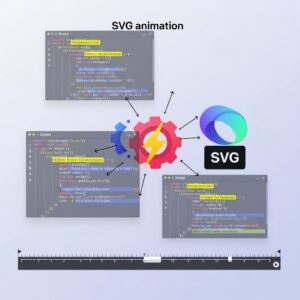The Complete Guide to Animating SVG with CSS
Scalable Vector Graphics (SVG) have become an essential part of modern web design, offering resolution-independent graphics that look crisp on any device. When combined with CSS animations, SVG becomes a powerful tool for creating engaging, interactive experiences. This comprehensive guide will walk you through everything you need to know about animating SVG with CSS.
Why Animate SVG with CSS?
CSS animations offer several advantages for SVG:
- Performance: CSS animations are hardware-accelerated in most browsers
- Simplicity: Easier to implement than JavaScript animations for basic effects
- Maintainability: Separates presentation from structure
- Responsiveness: Works well with responsive design principles
Getting Started with SVG Animation
- Create an SVG file. You can do this using a text editor or graphic design software like Adobe Illustrator, Inkscape, or Sketch. For simple shapes, you might write the SVG code directly:
<svg width="100" height="100"> <circle cx="50" cy="50" r="40" fill="red" /> </svg> - Add elements to your SVG file. This could be anything from basic shapes (circles, rectangles, paths) to text or even embedded images. Complex SVGs might include groups (<g> tags) and layers.
- Select elements to animate. You can target elements by:
- Tag name (circle, rect, path)
- Class (add class=”my-element”)
- ID (add id=”special-shape”)
- Add CSS properties. You can include CSS directly in your SVG file with <style> tags or link to an external stylesheet.
- Set animation properties. The core properties include duration, timing, and direction.
- Preview your animation. Open in a browser and test across devices.
Advanced CSS Animation Properties
Beyond the basics, CSS offers powerful animation controls:
- animation-duration: Set in seconds (s) or milliseconds (ms). For micro-interactions, try 0.3s; for prominent animations, 1-2s.
- animation-timing-function: Beyond linear, try:
- ease (default)
- ease-in (starts slow)
- ease-out (ends slow)
- cubic-bezier() for custom curves
- steps() for frame-by-frame animation
- animation-direction: Combine with iteration-count for interesting effects:
- normal (default)
- reverse (backwards)
- alternate (ping-pong)
- alternate-reverse
- animation-fill-mode: Controls styles before/after animation:
- none (default)
- forwards (keeps end state)
- backwards (applies first keyframe immediately)
- both
- animation-play-state: Useful for pausing animations on hover:
- running
- paused
Practical Animation Examples
1. Loading Spinner
<svg viewBox="0 0 50 50">
<circle class="spinner" cx="25" cy="25" r="20"/>
</svg>
<style>
.spinner {
animation: rotate 2s linear infinite;
stroke-dasharray: 80;
stroke-dashoffset: 60;
stroke: #4285F4;
fill: none;
stroke-width: 5;
}
@keyframes rotate {
100% { transform: rotate(360deg); }
}
</style>2. Morphing Shapes
Using CSS with SVG path elements:
<svg viewBox="0 0 100 100">
<path class="morph" d="M20,20 L80,20 L80,80 L20,80 Z"/>
</svg>
<style>
.morph {
animation: morph 4s ease-in-out infinite alternate;
fill: #34a853;
}
@keyframes morph {
50% { d: path("M30,30 Q50,10 70,30 T90,50 T70,70 T50,90 T30,70 T10,50 T30,30"); }
}
</style>
Performance Optimization Tips
- Use transforms: Properties like translate, rotate, and scale are more efficient than animating top/left.
- Limit simultaneous animations: Too many concurrent animations can cause jank.
- Use will-change: Hint to browsers which elements will animate:
.animated-element { will-change: transform, opacity; } - Reduce complexity: Simplify SVG paths when possible.
- Test on mobile: Mobile devices have less GPU power.
Cross-Browser Considerations
While SVG and CSS animations have excellent browser support, consider:
- IE11 has limited SVG SMIL animation support (use CSS instead)
- Prefixes may be needed for older browsers (-webkit-, -moz-)
- Test reduced motion preferences:
@media (prefers-reduced-motion: reduce) { * { animation-duration: 0.01ms !important; } }
Taking It Further
Combine CSS animations with:
- JavaScript: For complex sequencing or interactive animations
- SVG filters: Add blur, lighting, or other effects
- CSS variables: For dynamic control of animations
- Web Animations API: For more control than CSS alone
Remember that animation should enhance user experience, not distract from content. Use animations purposefully to guide attention, provide feedback, or explain relationships between elements.
Resources for Learning More
- MDN’s SVG documentation
- CSS-Tricks SVG animation guides
- Codepen SVG animation examples
- SVG animation tutorials on YouTube










